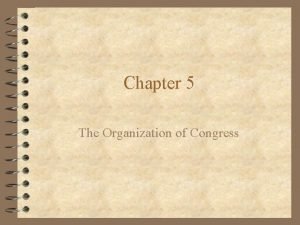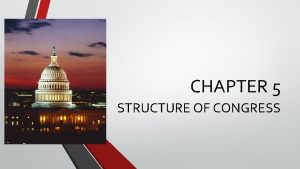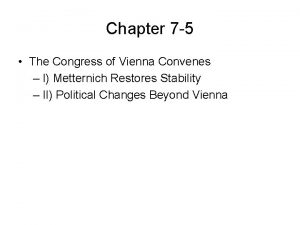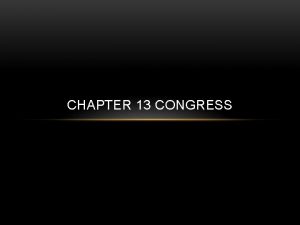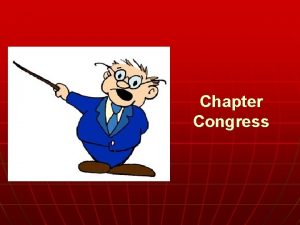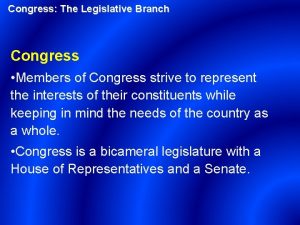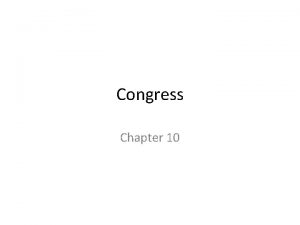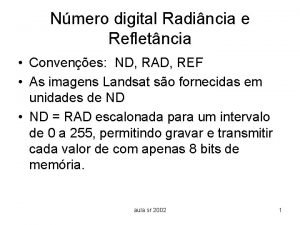The Organization of Congress Congress Convenes Congress convenes















- Slides: 15

The Organization of Congress

Congress Convenes Ø Congress convenes every two years—on January 3 of every odd-numbered year. Ø The House has formal organizational meetings at the beginning of each term to determine committee membership and standing officers. Ø The Senate, because it is a continuous body, has fewer organizational issues to address at the start of each term. Ø When Congress is organized, the President presents a State of the Union message to a joint session of Congress. This message, in which the President reports on the state of the nation as he sees it, is given annually.

House of Representatives

The Speaker of the House Ø Is elected by the members of the House Ø Acknowledged as the leader of its party

Duties of the Speaker of the House Ø No member can speak without authorization of the Speaker Ø Puts motions to a vote Ø Decides the outcome of most votes Ø Names the members of all committees Ø Signs all bills and resolutions passed by the House

The Party Caucus Ø The party caucus is a closed meeting of the members of each party in each house which deals with matters of party organization.

Floor Leaders Majority Floor Leader Ø Chosen by their party colleagues. Ø Next to the Speaker, they are the most important officers in Congress. Minority Floor Leaders Ø Chosen by their party colleagues. Ø assist the floor leaders and serve as a liaison between the party’s leadership and its rank-and-file members.

The Floor Leaders Duties Ø Legislative strategists Ø Steers floor action to their parties benefit Ø Chief spokesman for his party Ø Majority leader is more powerful

Whips Duties ØAssistants to the floor leaders ØChosen by the members of their party ØTwo-way link between the floor leaders and the members of the party.

The Senate

The President of the Senate Ø The Constitution states that the Vice President is the President of the Senate Ø Senate does not choose its own leader Ø Is not a member of the body he represents Ø Less powerful than the Speaker of the House

Duties of the President of the Senate ØRecognizes members ØPuts questions to a vote ØCannot speak on an issue ØMay only vote to break a tie

President Pro Tempore Ø Serves in Vice Presidents Absence Ø Elected by the Senate Ø Follows the Speaker in the line of Presidential succession

Committee Chairmen and Seniority Rule Ø The seniority rule, an Ø The committee unwritten custom, holds that chairmen are the most important posts will members who head the standing committees in be held by those party each chamber of members with the longest Congress. records of service in Congress. Ø The chairman of each of these permanent Ø The head of each committees is chosen is often the longest-serving from the majority party member of the committee by the majority party from the majority party. Committee Chairmen caucus.

Review 1. The presiding officer of the House of Representatives is l (a) the President. l (b) the Speaker of the House. l (c) the majority whip. l (d) the president pro tempore. 2. The party whips are responsible for all of the following EXCEPT l (a) serving as a liaison between party leaders and rank-and-file members. l (b) presiding over the House or Senate. l (c) informing the floor leader of anticipated vote counts in key decisions. l (d) seeing that all members of the party are present for important votes.
 First continental congress definition
First continental congress definition First continental congress convenes
First continental congress convenes The organization of congress chapter 5
The organization of congress chapter 5 The organization of congress chapter 5
The organization of congress chapter 5 Compare and contrast organization
Compare and contrast organization Process organization in computer organization
Process organization in computer organization Bổ thể
Bổ thể Vẽ hình chiếu đứng bằng cạnh của vật thể
Vẽ hình chiếu đứng bằng cạnh của vật thể Nguyên nhân của sự mỏi cơ sinh 8
Nguyên nhân của sự mỏi cơ sinh 8 Phản ứng thế ankan
Phản ứng thế ankan Thiếu nhi thế giới liên hoan
Thiếu nhi thế giới liên hoan Alleluia hat len nguoi oi
Alleluia hat len nguoi oi điện thế nghỉ
điện thế nghỉ Một số thể thơ truyền thống
Một số thể thơ truyền thống Trời xanh đây là của chúng ta thể thơ
Trời xanh đây là của chúng ta thể thơ Các số nguyên tố
Các số nguyên tố


